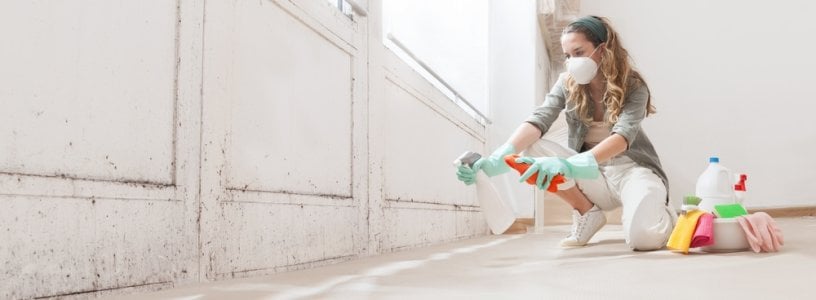Eradicate Wall Mould in a Flash with This Shockingly Simple 4-Step Cleaning Hack!
By
Seia Ibanez
- Replies 4
Mould on walls is a common issue in many Australian homes, and it's not just an unsightly nuisance—it can also pose health risks, particularly for those with allergies or respiratory issues. The damp climate in parts of Australia provides the perfect breeding ground for mould, and according to research from the University of Melbourne, up to 25% of homes down under are grappling with dampness and mould problems. But fear not, because with the right approach, you can tackle this pesky problem head-on and reclaim the cleanliness of your walls.
Understanding the urgency of addressing mould is crucial. If left unchecked, mould can penetrate deeper into your walls, causing more significant damage and potentially leading to costly repairs. Moreover, the presence of mould, whether dead or alive, can trigger allergic reactions similar to hay fever, as the allergens remain potent.
So, let's dive into the surprisingly simple four-step method that can help you remove mould from your walls permanently and prevent it from making an unwelcome comeback.
**Step 1: Gather Your Supplies**
Before you begin, you'll need to arm yourself with the right tools for the job. Here's what you'll need:
- Dishwashing detergent
- Two microfibre cloths (Why microfibre? These cloths are designed to pick up substances from surfaces rather than just smearing them around.)
- Thyme or oregano essential oils (optional, but they can 'supercharge the effect,' according to cleaning experts)
- Water
**Step 2: Prepare Your Cleaning Solution**
Start by cutting your microfibre cloths into squares. Then, mix dishwashing detergent with warm water to create a soapy solution. If you're using them, add a few drops of thyme or oregano essential oils to the mix. These oils have natural antimicrobial properties that can enhance the mould-fighting power of your solution.
**Step 3: Wipe Down the Mould-Affected Areas**
Dip a square of microfibre cloth into the soapy solution and thoroughly wipe down the mould-affected surface. Use each side of the square once before discarding it to prevent cross-contamination and the spread of mould spores.
**Step 4: Address the Underlying Causes**
To ensure the mould doesn't return, it's essential to identify and rectify any underlying issues that may be contributing to excess moisture. This could involve fixing leaks, improving ventilation, or using a dehumidifier with a true HEPA filter to purify the air and reduce humidity.
**Does Vinegar Kill Mould?**
While vinegar is often touted as a natural mould killer, its strong odour can be off-putting. Some people prefer using dishwashing detergent with essential oils for a more pleasant scent. Clove oil is another popular natural alternative known for its mould-killing properties.
**Preventing Mould Growth in Your Home**
Prevention is always better than cure, so here are some tips to keep mould at bay:
- Open your windows daily to allow fresh air to circulate, even during the cooler months.
- Wipe down any condensation you notice on your windows.
- Promptly fix leaks and clean up water spills.
- Utilize exhaust and extractor fans, especially after hot showers, to remove excess moisture.
- Consider using a dehumidifier with an air purifier that features a true HEPA filter to maintain optimal indoor air quality.
By following these steps and maintaining good household habits, you can effectively remove and prevent mould in your home, ensuring a healthier living environment. Remember, if the mould infestation is significant or caused by a serious water leak, it's best to call in a professional to safely and effectively deal with the issue.

We'd love to hear from you, dear members! Have you tried this method, or do you have any other mould-busting tips to share? Drop us a comment below and join the conversation!
Understanding the urgency of addressing mould is crucial. If left unchecked, mould can penetrate deeper into your walls, causing more significant damage and potentially leading to costly repairs. Moreover, the presence of mould, whether dead or alive, can trigger allergic reactions similar to hay fever, as the allergens remain potent.
So, let's dive into the surprisingly simple four-step method that can help you remove mould from your walls permanently and prevent it from making an unwelcome comeback.
**Step 1: Gather Your Supplies**
Before you begin, you'll need to arm yourself with the right tools for the job. Here's what you'll need:
- Dishwashing detergent
- Two microfibre cloths (Why microfibre? These cloths are designed to pick up substances from surfaces rather than just smearing them around.)
- Thyme or oregano essential oils (optional, but they can 'supercharge the effect,' according to cleaning experts)
- Water
**Step 2: Prepare Your Cleaning Solution**
Start by cutting your microfibre cloths into squares. Then, mix dishwashing detergent with warm water to create a soapy solution. If you're using them, add a few drops of thyme or oregano essential oils to the mix. These oils have natural antimicrobial properties that can enhance the mould-fighting power of your solution.
**Step 3: Wipe Down the Mould-Affected Areas**
Dip a square of microfibre cloth into the soapy solution and thoroughly wipe down the mould-affected surface. Use each side of the square once before discarding it to prevent cross-contamination and the spread of mould spores.
**Step 4: Address the Underlying Causes**
To ensure the mould doesn't return, it's essential to identify and rectify any underlying issues that may be contributing to excess moisture. This could involve fixing leaks, improving ventilation, or using a dehumidifier with a true HEPA filter to purify the air and reduce humidity.
**Does Vinegar Kill Mould?**
While vinegar is often touted as a natural mould killer, its strong odour can be off-putting. Some people prefer using dishwashing detergent with essential oils for a more pleasant scent. Clove oil is another popular natural alternative known for its mould-killing properties.
**Preventing Mould Growth in Your Home**
Prevention is always better than cure, so here are some tips to keep mould at bay:
- Open your windows daily to allow fresh air to circulate, even during the cooler months.
- Wipe down any condensation you notice on your windows.
- Promptly fix leaks and clean up water spills.
- Utilize exhaust and extractor fans, especially after hot showers, to remove excess moisture.
- Consider using a dehumidifier with an air purifier that features a true HEPA filter to maintain optimal indoor air quality.
By following these steps and maintaining good household habits, you can effectively remove and prevent mould in your home, ensuring a healthier living environment. Remember, if the mould infestation is significant or caused by a serious water leak, it's best to call in a professional to safely and effectively deal with the issue.
Key Takeaways
- Mould in homes can be a common issue, affecting up to a quarter of Australian households, and should be addressed quickly to prevent damage.
- Microfibre cloths and vacuum cleaners with HEPA filters are recommended for removing mould, along with a cleaning mixture of dishwashing detergent, water, and optional essential oils like oregano and thyme.
- While vinegar is effective against mould, the potent smell can be off-putting, making a dishwashing detergent solution with essential oils an alternative.
- Preventing mould involves daily ventilation, managing condensation, repairing leaks promptly, using exhaust fans, and potentially employing a dehumidifier with a true HEPA filter air purifier.
We'd love to hear from you, dear members! Have you tried this method, or do you have any other mould-busting tips to share? Drop us a comment below and join the conversation!








